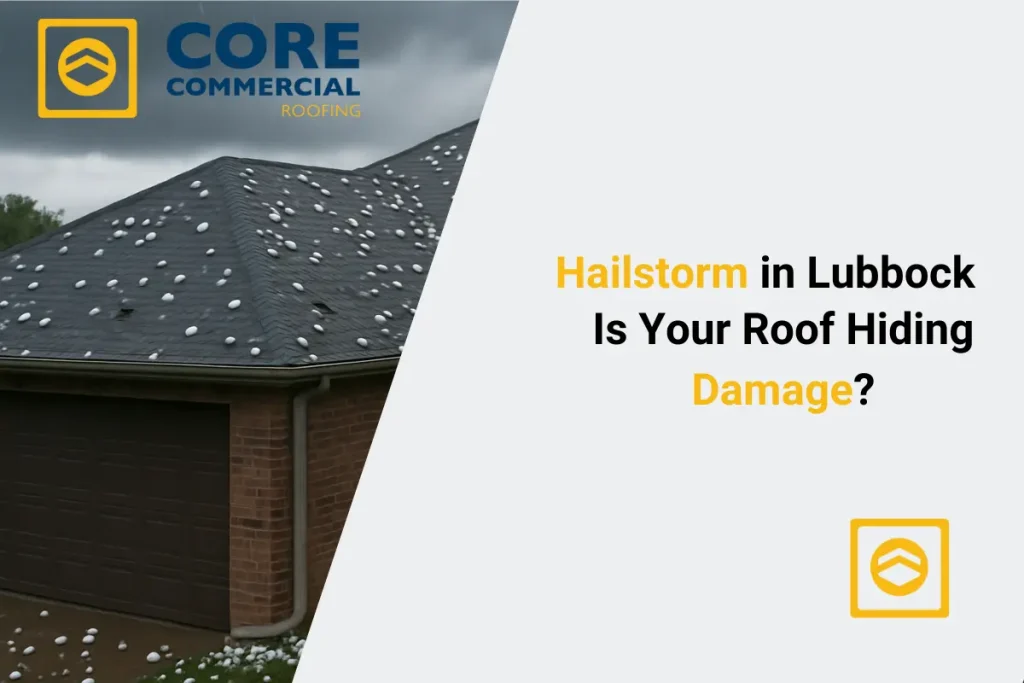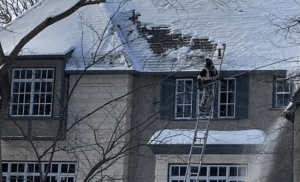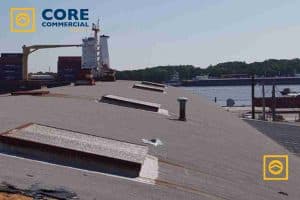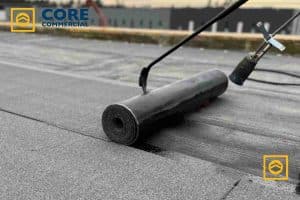When hailstorms hit Lubbock, the damage isn’t always obvious. You might glance at your roof and think everything looks fine. However, hail damage can often be hidden in plain sight , and if left unaddressed, it can lead to costly problems, including leaks, mold, and structural decay. This guide helps homeowners in Lubbock understand what hail does to a roof, how to spot signs of trouble, and what steps to take before the damage worsens. If you’re wondering whether your roof took a hit during the last storm, this article walks you through everything you need to know.

Table of Contents
1. What Makes Lubbock Hailstorms So Dangerous?
Lubbock sits in what meteorologists call “Hail Alley.” It’s a stretch of land in the Southern Plains that regularly sees hailstones the size of golf balls, sometimes even bigger. These storms come fast and hard, often in the spring and early summer. While they may last just minutes, the damage they leave behind can take months or even years to surface if ignored.
The wide-open skies of Lubbock don’t just give beautiful sunsets, they also give hail room to gain speed and size as it falls. That’s why even newer roofs can suffer after just one strong storm.
You can check our blog post: steps to prevent roof leaks
2. Why Roof Damage Often Goes Unnoticed
Most people don’t think about their roofs unless something’s leaking. But hail doesn’t always punch holes through shingles or leave massive dents you can see from the ground. Instead, it often causes subtle bruising on asphalt shingles, loosens granules, or weakens sealants around vents and flashing.
Even small hailstones, around 1 inch in diameter, can loosen the top protective layer of your shingles. Over time, UV rays and rain do the rest, turning that small bruise into a major issue.
If you’ve ever walked outside after a storm and thought, “Well, the roof looks fine,” you’re not alone. But looks can be deceiving.
3. What Hail Damage Looks Like
Here are some things to check for — even from the ground:
- Bald spots on shingles where granules are missing
- Soft, bruised areas that feel spongy when pressed (if safely accessible)
- Dented gutters or downspouts, which signal hail impacts
- Shingles with cracked edges or corners
- Missing shingles (less common with hail, but still worth noting)
Inside the attic or home, signs might include:
- Damp wood or insulation
- Water stains on ceilings
- Moldy smells or increased indoor humidity
Remember, not all damage is instant. Some signs may take weeks or months to show up.
4. The Hidden Costs of Ignoring Roof Damage
Here’s what can happen when hail damage goes unnoticed:
- Leaks and water intrusion
- Rotting wood and structural damage
- Mold growth in attic insulation and walls
- Higher energy bills due to poor roof insulation
- Shortened roof lifespan (even if it “looks fine”)
What’s worse is that insurance claims are often time-sensitive. If you delay too long, your claim might be denied, even if the damage can be proven.
5. How to Inspect Your Roof Safely (Without Climbing Up)
You don’t need to get on a ladder to start checking your roof. Here’s how you can safely assess the situation:
- Use binoculars to check for missing or damaged shingles
- Walk around your home and look for dents in gutters or metal trim
- Check your deck, patio furniture, or car for hail dents (they’re a clue that your roof took hits too)
- Look inside the attic for water stains or damp smells
If anything looks suspicious, call a professional, don’t risk climbing a steep or slippery roof yourself.
6. Signs You May Have Hail Damage Inside Your Home
Sometimes, the first clues aren’t on the roof at all. Hail damage can lead to issues indoors, such as:
- Water stains or discolored patches on ceilings
- Peeling paint or bubbling drywall
- A sudden mildew or musty smell
- Light flickering (if water has reached wiring)
These problems may seem unrelated at first, but they often trace back to hidden roof leaks caused by storm damage.
7. Why Time Matters: The Sooner You Act, the Better
Here’s why waiting can hurt you:
- Insurance deadlines often range from 6 to 12 months
- Damage compounds over time, especially with rain or high winds
- You may forget the exact date of the storm, weakening your claim
- The longer you wait, the harder it is to prove hail was the cause
Quick action can save you thousands. A basic inspection today could prevent major repairs next season.
8. Do You Need a Roof Replacement or Just Repairs?
Not all hail damage requires a full replacement. Here’s a breakdown:
- Minor damage, like a few bruised shingles: Spot repairs may be enough
- Moderate damage (multiple areas): Sectional replacement is possible
- Severe damage (compromised structure, widespread leaks): Full replacement might be necessary
The key is getting an honest inspection, someone who tells you what’s needed, not just what’s most expensive. You can check the commercial roofing inspection checklist
9. What to Expect from a Professional Roof Inspection
A good roof inspection in Lubbock should include:
- A thorough walkaround of the entire perimeter
- Drone footage or ladder access for full visibility
- Photos of any problem areas
- An inspection report for your insurance or records
- Clear explanation of what’s urgent, what can wait, and what’s purely cosmetic
Most reputable local roofers offer free inspections, especially after storms.
10. Insurance Tips for Hail Damage Claims
Here’s how to navigate the claim process:
- Document everything: Take photos before and after the storm if possible
- Save news reports or radar maps showing storm dates
- Request a detailed inspection report from your roofer
- File promptly — delays can hurt your eligibility
- Don’t rely solely on the insurance adjuster’s opinion — you can bring your roofer to meet them
Also, beware of “lowball settlements.” If something feels off, get a second opinion.
11. Avoiding Storm Chasers: How to Pick the Right Local Help
After a hailstorm, Lubbock often sees an influx of out-of-town contractors, known as storm chasers. They move from city to city chasing insurance jobs. While some are legit, many disappear before you can call them back for a warranty issue.
To avoid regret:
- Check local reviews and ratings
- Verify licenses and insurance
- Look for Lubbock-based offices
- Ask for references in your neighborhood
- Beware of pressure tactics like “sign now or lose your deal.”
Trust is key. Choose someone with roots in your community.
12. Final Thoughts: Peace of Mind Starts with Awareness
You don’t need to panic after a hailstorm, but you shouldn’t ignore it either. Lubbock weather is unpredictable, and your roof is your first line of defense. Hidden hail damage can cost you more than just money. It can affect your home’s safety and your peace of mind.
Start with awareness. Then take the next right step.
Even if you’re unsure whether your roof has any issues, a quick professional inspection can give you the clarity you’re looking for. From there, you’ll know exactly what your building needs, whether it’s a minor repair, preventative maintenance, or simply the peace of mind that everything is in good shape.
FAQs
How do I check my Lubbock roof for hail damage?
First, stay safe and view your roof from the ground. Use binoculars to look for missing or cracked shingles, dark spots from granule loss, and dents in gutters or vents. Check cars and yard items for hail marks — if they show damage, your roof probably did too. If anything seems off, schedule a professional inspection.
What size hail damages Lubbock roofs?
Can hail roof damage hide under shingles?
Yes. Hail often causes bruises on the asphalt layer that don’t show from the ground. You might see granules in the gutters or feel soft spots under shingles. Damage may not show until weeks or months later, when leaks or mold start.
Should I call my insurance after the Lubbock hailstorm?
Yes — most Texas homeowners’ policies cover hail damage. File quickly (usually within a year). Provide photos of damage and inspection reports. A contractor can meet the adjuster to ensure all damage is documented.
How long do I have to file a hail claim in Texas?
Typically, you have up to one year after the storm to file a claim. But filing early is better — delays or more storms can hurt your case, so report damage as soon as possible .
What are common signs of hidden roof leaks?
Look inside your attic or ceilings for brown stains, peeling paint, damp insulation, musty smells, or higher indoor humidity. Small roof dents can turn into leaks that show weeks later .
Do I need a full roof replacement after hail in Lubbock?
Not always. A few bruised shingles may just need spot repairs. But heavy hail damage, widespread granule loss, structural issues, or leaks may mean a full replacement is needed—best decided after a professional inspection.
Who inspects hail damage in Lubbock?
Look for a local, licensed, and insured roofer with Lubbock experience. They should offer free inspections, use drones or ladders, take photos, and give a clear report—especially helpful for insurance claims .
How to avoid storm chaser roofers?
After hailstorms, many out-of-town storm chasers appear. Choose a local roofer: check reviews, ask neighbors, verify a physical Lubbock office, get licenses and insurance info, and avoid high-pressure sign-now tactics.
Can I spot hail damage by looking at my car?
Yes! Dents in cars, AC units, or yard furniture after a storm often mean hail hit your roof, too. If you see those in Lubbock, it’s smart to inspect the roof or call a pro.






